|
|
|
|
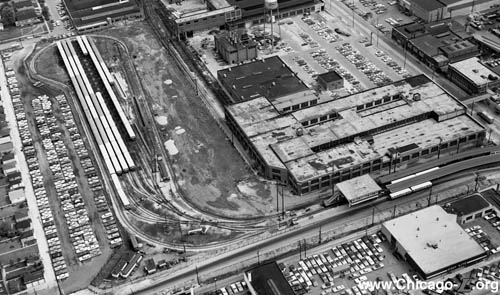
54th Yard is seen in this aerial view looking north in 1969. The inspection pits are along the east edge of the yard inside the loop track. The Cicero-Berwyn station is visible in the lower right corner. For a larger view, click here. (CTA photo) |
|
|
|
|

54th Yard is seen in this aerial view looking north in 1969. The inspection pits are along the east edge of the yard inside the loop track. The Cicero-Berwyn station is visible in the lower right corner. For a larger view, click here. (CTA photo) |
54th Yard &
Shops
54th Avenue and 21st
Street, Town of Cicero
Service Notes:
Located:
Pink Line: Cermak (Douglas)
Quick Facts:
Established: between 1912 and 1921
Address:
2150 S. 54th Avenue (54th Yard)
2134 S. 54th Avenue (54th Transportation Office)
Shop Area: 27,350 square feet
Yard Area: 231,700 square feet
Yard Capacity: 100 cars
Rebuilt: 2002-03
Status: In Use
A short extension of the Douglas Park branch from 52nd Avenue to 56th Avenue opened on August 1, 1912. By 1921, a small yard was built at 54th Avenue, on the west side of the street across from the station, to supplement the branch's main yard at 40th Avenue (Pulaski). The yard consisted of eight tracks, lined up next to one another extending straight north from a pair of yard leads connecting to the main line tracks. A ninth track was located about 100 feet east of the others, close to the east property line. The yard included a small office and lamp house at the southwest corner of the yard near the main line tracks, but no maintenance shop. Maintenance was performed at the 40th Avenue Shop. An interlocking tower at the south end of the yard controlled access to and from the yard and the main line.
On February 3, 1952, the CTA trimmed Douglas service back to 54th Avenue station. This modest station on a minor street was most likely chosen because of the small yard that already existed just west of the station, making it a convenient place to terminate the line. The station was rebuilt as a grade-level terminal, including an interlocking tower to monitor the modest train yard, and renamed Cicero-Berwyn Terminal. The new terminal opened on May 25, 1952, three months after service was cut back from Oak Park to 54th. Around the same time, the yard was reconfigured to include a loop track that went around the straight storage tracks in the middle of the property. The loop track made it easy to turn trains at the end of their trips. Operation of the terminal loop at 54th Avenue began March 2, 1952. The yard throat and leads connecting to the main line tracks at the station were also reconfigured.
On December 13, 1953, the new Douglas Park transportation office, an elevated structure located over the platforms at the Cicero-Berwyn Terminal, was officially opened. Train crews and agents began reporting at the new terminal with the midnight run on that date. At the same time, the offices of the Station Superintendent and Receiver at the Pulaski Yard terminal were permanently closed.
Circa 1959, an additional track was added inside the loop track, east of the storage tracks. This track included an inspection pit, allowing inspections and light maintenance to be performed at the yard more easily. The additional track expanded the yard's capacity from 116 cars to 124. In 1962, Pulaski Yard was closed, moving all car storage and any maintenance performed on the branch to 54th Yard. However, car maintenance at 54th was limited, performed from inspection pits on some of the yard tracks out in the open. Unprotected from temperature and weather, this made for a very unpleasant situation. Only light work was performed at the yard, with cars deadheaded to Desplaines or Skokie shops for heavy maintenance work. Around 1970, a shed was added over one pit, but it was little help. In the mid-1970s, a second pit was added on the track adjacent to the west of the existing pit.
Finally, by 1976, a two-track light repair shop was built. Each track had a four-car capacity. A two-track expansion of this facility was initiated in 1993, including installation of a wheel-truing machine. Wheel-truing machines are essentially large lathes, used to remove flat spots from train wheels. These flats spots, though subtle, are highly problematic, creating a pounding noise at slow operating speeds and a continuous rumble at high speeds. They are often created by excessive use of the track brake by inpatient motormen and are a large contributor to train noise; flat spots in wheels also put more wear on the rails. The wheel-truing machine was installed in 1995, and on June 29 that year a clearance train (using a Marmon Transmotive snow remover) was run through it.
Douglas Renovation Project
On August 5, 1998, the CTA Board approved a $2,131,551 contract to McDonough Associates, Inc., of Chicago to design improvements along the street-level portion of the Cermak (Douglas) branch between Kildare and the terminal at 54th/Cermak. As part of the CTA's Douglas Rehabilitation Project, also known as "Renew the Blue", the Authority moved the 54th/Cermak station to the east and built an entirely new terminal facility, transportation office, and expansion of 54th Yard's storage capacity from 88 to approximately 100 cars. The train yard stayed in the same location, though the leads to the main line were rearranged somewhat. The new Transportation Office, however, is located on the site of the former station.
On Tuesday, October 22, 2002, construction on a portion of the track connection leading from the yard's loop track to the rail maintenance shop was completed and Shop Track B was returned to service. As a result of ongoing construction, Shop Tracks C and D remained out-of-service until Thursday, October 31, when construction of the tracks was completed.
In the old yard, utilities, running rails, and traction power ductbanks were installed through November 2002. Concrete work was also done at the car washer during that time. In early December, new tracks were installed in the old yard, along with traction power switches, third rail and an ornamental iron fence around the perimeter. Third rail and traction power switches continued to be installed through late December, while conduit was installed at the Power & Way Facility. In late January 2003, gantry rail angles were installed at the car washer. In the new yard, a sound barrier wall foundation was installed in early December 2002, as was a cast-in-place sidewalk and ornamental iron fencing. Switch heaters were installed on some of the new tracks while punchlist items were completed on some of electrical and construction work. Over the weekend of March 22-23, 2003, work in the old yard centered around pulling and splicing traction power cables, while work in the new yard concerned installing poles for lighting, for the fire alarm system and for public address system.
Construction also began on the new Transportation Office, which is situated where the old Cicero-Berwyn Terminal was located. The new building is actually located in the middle of the old right-of-way, so the yard leads connecting the yard to the station across 54th Avenue were realigned to veer to the south to go around the office building before entering the 54th Yard. Concrete work was undertaken at the new Transportation Office through November 2002, when the new adjacent parking lot was also paved with asphalt. By early January 2003, the building was taking shape, with roof joists being set and the roof decking being installed. In late January, masonry work was undertaken at the Transportation Building. As of early March 2003, the building's structure is substantially complete, with electric work on conduit and fixtures now progressing. This weekend, curtain walls will be set, roofing will be installed and conduit and pull wires will be installed.
In late March 2003, work was progressing on the new Transportation Office building, including setting curtain walls, installing roofing, and installing conduit and pulling wires. The Track and Signal Maintenance building also received electrical work during that time. Elsewhere in the old yard, work on the new car washer continued and conduits and wires were installed in the new communications hut. Meanwhile, in the new portions of the yard, poles were installed for lighting, the fire alarm system, and the public address system and electric punchlist work continued. By early April, light poles were being installed in the old yard as well.
In mid-April, the car washer facility began to be painted. Through the month, electric work at the Transportation Office and Track and Signal Maintenance building continued, as did roof work at the former. Also continuing was pole installation and cable pulling in the new yard. By May 2003, work in the old yard was beginning to wrap up. Yard walkways were installed and cables pulled over May 3-4, while pole installation in the old and new yards continued along with electrical work in the Transportation Office building. Meanwhile in the Transportation Office building, insulated wall panels were installed. By mid-May, punchlist work was underway in both the electrical and construction trades in both the new and old yards.
By June, a lot of work centered on the new yard buildings. Curtain walls were installed in the new Transportation Office building and a tactile edge was installed at on the track side of the platform of the building. Later in the month, the Track and Signal Maintenance building had painting done and its acoustical ceiling installed while the Transportation Office building had roofing and painting work done and repairs made to its concrete floor. Over June 28-29, electrical switchgear was replaced in the 54th Shop.
During July 2003, painting was completed at the Track and Signal Maintenance building, while work began on the HVAC at the Transportation Office. Ornamental fencing was also installed around the latter during this period. Roofing was installed on both the Track and Signal Maintenance and Transportation Office buildings. In August, resilient flooring was installed at the Track and Signal Maintenance building and track marker signs were installed in the west yard. Meanwhile, drywall and metal plank ceilings were installed in the Transportation Office. By September, both buildings, as well as the car washer, shop, electrical and communication systems, and trackwork in the yard were nearing completion and punchlist work was underway for all of them.
As of October 15, 2003, work in 54th Yard was considered complete. In the end, the renovated yard included new trackwork, new fencing, a new Transportation Office, a new Yard Office, a new Track and Signal Maintenance Building, and a new car washer. Car capacity in the yard was expanded from 88 cars to approximately 100 cars.
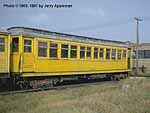 |
ctaS-219.jpg (42k) S-219 has always been a snowplow car, but there have actually been more than one. The first S-219 was a Metropolitan Division service car built in 1930 from CRT car 2726. This car survived into the CTA era, but was scrapped. A replacement S-219 was converted from an unknown car of the 2858-2927 series by CTA in October 1957, entering service the next year. That car, seen at left in the 54th Avenue Yard in October 1963, was retired in January 1966. (Photo by Jerry Appleman) |
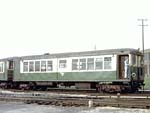 |
cta4072.jpg
(51k) |
|
|
cta6000s@54thYard.jpg
(49k) |
 |
cta4272i.jpg
(122k) |
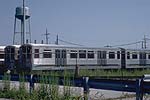 |
cta2202b.jpg
(103k) |
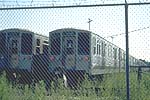 |
cta2239-2202.jpg (180k) |
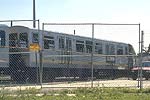 |
cta2299.jpg (138k) |
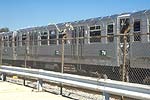 |
cta2229.jpg (128k) |
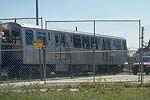 |
cta2936.jpg (108k) |
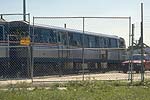 |
cta3101.jpg (126k) |
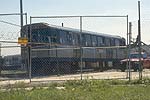 |
cta3135.jpg (122k) |
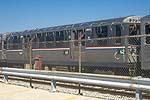 |
cta3193b.jpg (112k) |
|
|
54thYard01.jpg
(161k) |
|
|
54thYard-TranspOfficeNew01.jpg
(183k) |
|
|